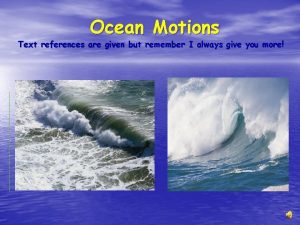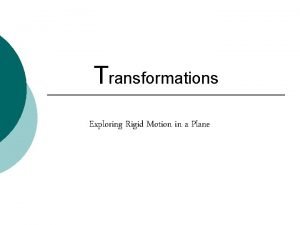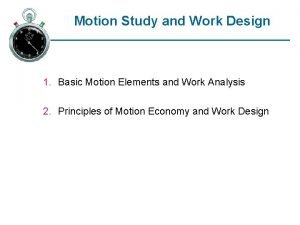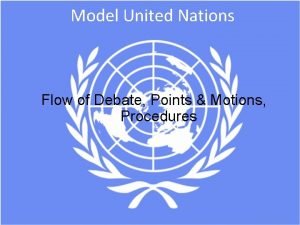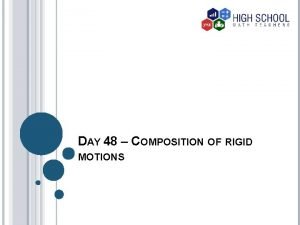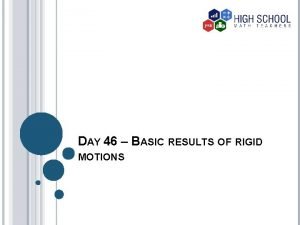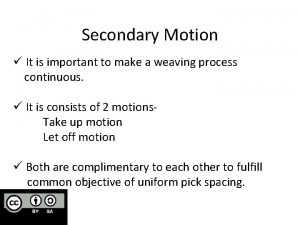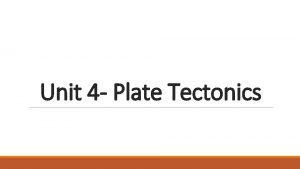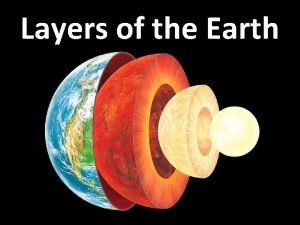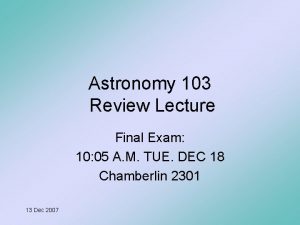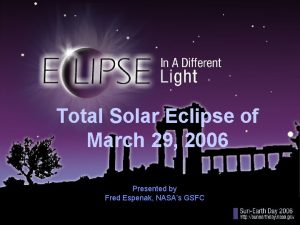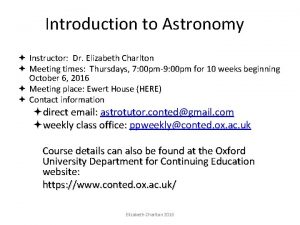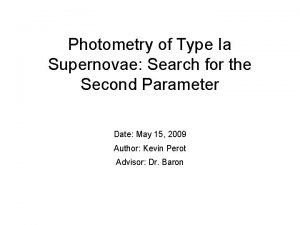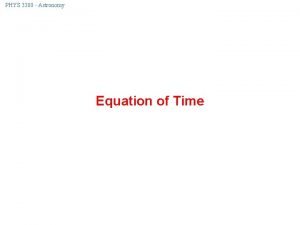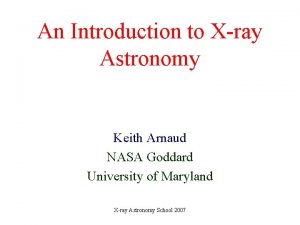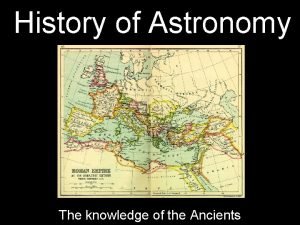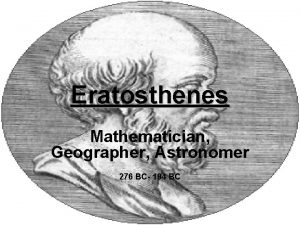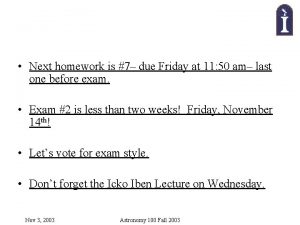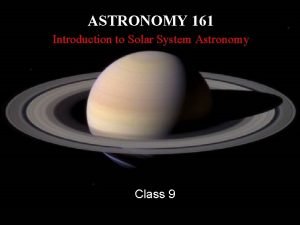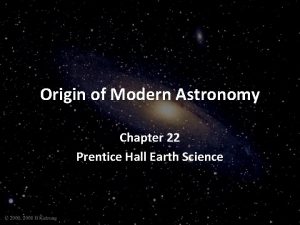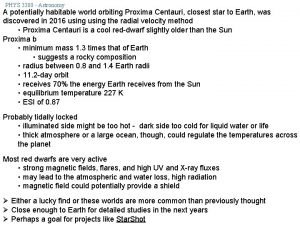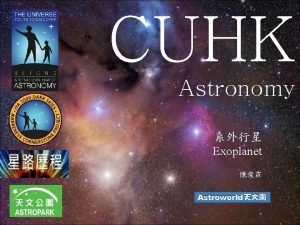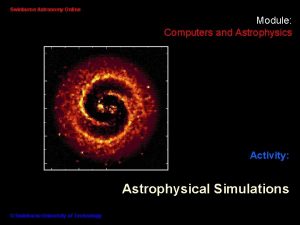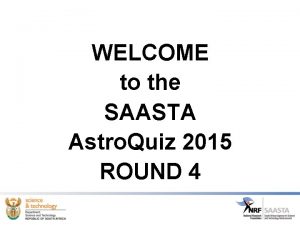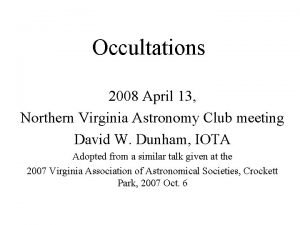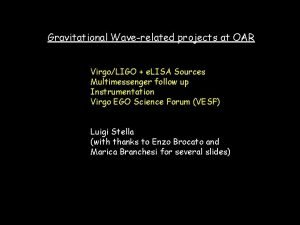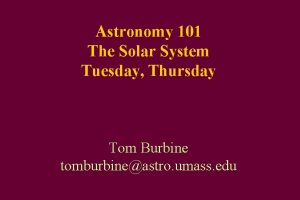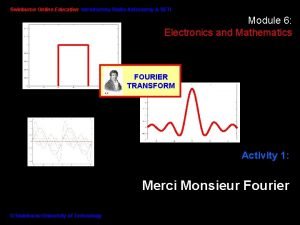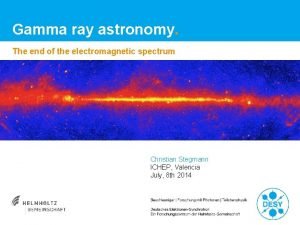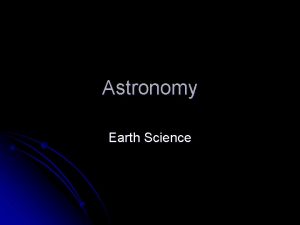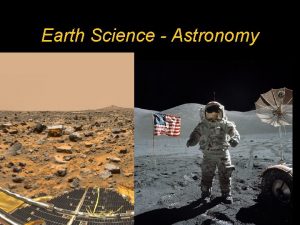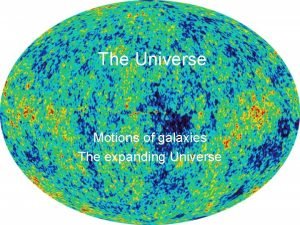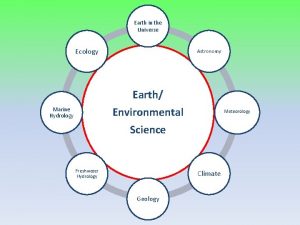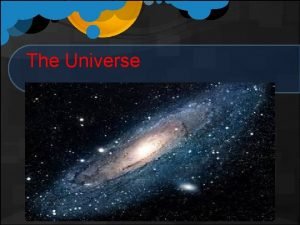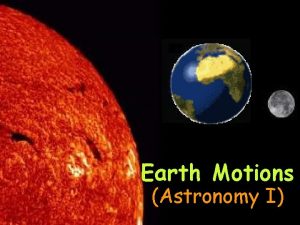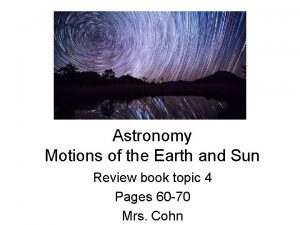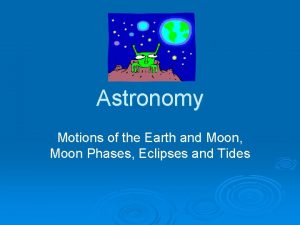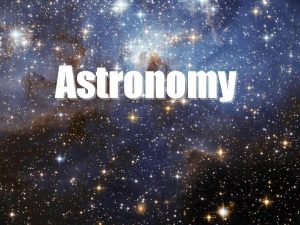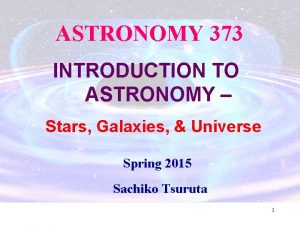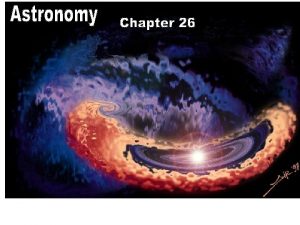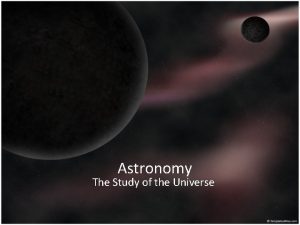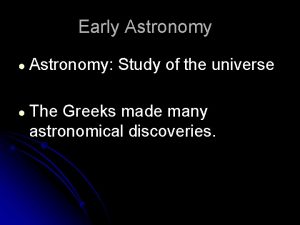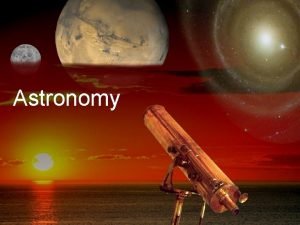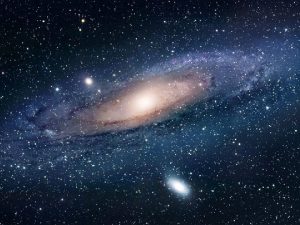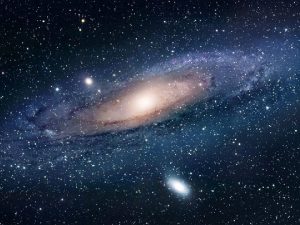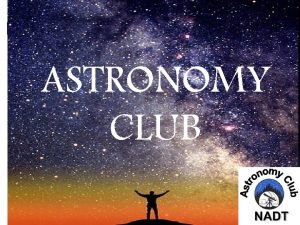Astronomy Part 2 Earth in the Universe Motions



























































































- Slides: 91

Astronomy Part 2 Earth in the Universe Motions of Earth, Moon, and Sun

Earth in the Universe

Eccentricity and Ellipse An ellipse is an oval shape. n Earth’s orbit around the sun is an ellipse. n Within an ellipse, there are two fixed points called foci. n In our solar system, the sun is ALWAYS ONE of those foci. n

An ellipse is an example of a “conic section”. Circles and hyperbolas are others. All are possible forms for orbits. You can make an ellipse with 2 tacks and a string. The tacks are the “foci”, and if you put them further apart, the ellipse is more “eccentric” (one tack makes a circle).

Eccentricity and Ellipses n The degree of flatness or “ovalness” of an ellipse is measured by eccentricity. n This formula is on page 1 of your ESRT!

Pg 1 ESRT

Eccentricity and Ellipse n The more oval the orbit is, the more eccentric it is, or the higher the eccentricity. Increasing Eccentricity

Eccentricity and Ellipse n Calculating Eccentricity: Major Axis X Foci 1 X Foci 2

Eccentricity and Ellipse Calculating Eccentricity: n When you measure those 2 distances and calculate them, you will NEVER get higher than 1!! n The closer to 1 you are the MORE oval or eccentric the orbit. n The closer to 0 you are the LESS oval or eccentric the orbit. n

Gravitational Force n n n The closer 2 objects are to each other, the greater the gravitational pull between them. Therefore, during the perihelion – when Earth is closer to the sun, there is a greater gravitational pull between it and the sun. This makes the Earth speed up a bit in its orbit around the sun during that time.

Gravitational Force Perihelion Aphelion



Page 15 in ESRT – Turn there now!


The Big Bang Theory The universe started with a concentrated area of matter and energy. n 15 -20 billion years ago. n Then, it exploded and has been expanding ever since. n Faster moving stuff traveled farther. n

The Big Bang Theory n Matter began to clump together forming stars and galaxies. n The universe continued to expand is still expanding today.

The Big Bang Theory What proof do we have that the big bang did happen? n 1. Recently, scientists have found long -wave radiation coming from all directions in the universe. This is the energy that was created from the Big Bang. n 2. The universe is still expanding. n


Universe Expansion How do we know the universe is expanding? n Pg. 14 in the ESRT shows the electromagnetic spectrum. n Notice that in the visible spectrum there all the colors of the rainbow. n

Pg. 14 ESRT Shortwave Longwave

Universe Expansion n n When looking at the visible spectrum wavelengths are shifted either to the blue end (shorter wave) or the red end (longer wave). This shift in wavelengths is called the Doppler Effect. If they are shifted towards red, they are moving away from you. If they are shifted toward blue, they are coming towards you.

Universe Expansion n When scientists look at the universe, they see a red shift. This proves it is moving away from us, thus, expanding!

Red Shift Light from galaxies moving away Notice the shift to the red end

Blue Shift Light from galaxies moving toward us Notice the shift to the blue end



Galaxies The basic unit of matter in the universe is a galaxy. n A galaxy is a collection of billions of stars and gas and dust. n Our solar system is part of the Milky Way Galaxy. n The Milky Way is a spiral-shaped galaxy. n





Stars A star is usually a large ball of gas held together by gravity. n Produce tremendous amounts of energy and they shine. n Energy is produced by nuclear fusion – combination of nuclei of smaller elements to form nuclei of larger elements. n

Stars have different: n Size n Composition n Temperature n Color n Mass n Brightness n

Stars SIZE – 5 main categories: n 1. Medium sized n 2. Giants n 3. Supergiants (Largest) n 4. White Dwarfs n 5. Neutron Stars (smallest) n

Stars COMPOSITION n Mostly made up of hydrogen (60 -80%) n Most of the rest is helium. n About 1% of other elements. n Determined by looking at the color of the star. n

Stars n n n TEMPERATURE Color also indicates temperature hottest surface 50, 000 °C coolest -3000°C Blue are hottest stars. Red are coolest stars. Blue White Yellow 35, 000 °C 10, 000 °C 6, 000 °C Red. Orange 5, 000 °C Red 3, 000 ºC

Stars BRIGHTNESS n A measure of a stars brightness is its magnitude. n Apparent magnitude is how bright it looks from Earth. n Absolute magnitude is how bright it really is. n

Stars Hertzsprung-Russell Diagram: n Found that as temperature increased, so did absolute magnitude. n 90% of stars followed this pattern n Called main sequence stars n Other 10% were once main sequence stars but have changed over time. n

Absolute Magnitude Supergiants Ma in s Giants equ enc e Wh 50000 20000 ite D war 10000 fs 6600 6000 5000 3000

STAR EVOLUTION


The good news!! This is all for free on pg. 15 of the ESRT!

Our Solar System n n The solar system is the sun and all objects that orbit the sun under its gravitational influence. Our solar system has 1 sun and 8 planets.

Our Solar System n The Sun n An average star – Main Sequence n Over 1 million Earth’s would fit inside. n 1/4 the density of the Earth. n Made of 4 layers.

Putting things into perspective…

Putting things into perspective…

Putting things into perspective…

Putting things into perspective…

Putting things into perspective…

Solar Prominence

Remember - a lot of information about our solar system is free of charge on page 15 of your ESRT!!!


Motions of Earth, Sun, and Moon

Models of Apparent Motion Remember, apparent motions of celestial objects mean these objects appear to move, but really, it’s Earth that is moving. n There have been 2 main models to explain these apparent motions. n 1. Geocentric Model n 2. Heliocentric Model n

Models of Apparent Motion n n Geocentric Model: Early cultures believed this one. It says the Earth is the center of everything and all objects move around it. Geo = Earth

Models of Apparent Motion Heliocentric Model: n Model that is used and believed today. n It says the sun is the center of our solar system and everything moves around it. n Helio = sun n

Earth’s Motions n n n We know that the Earth rotates. However, HOW do we know this for sure? 1. The Focault Pendulum The path of the pendulum changes in a predictable way throughout the day. 2. The Coriolis Effect All particles on Earth, including wind, are deflected or curved from their original path.

The Motions of the Moon n n Revolution – Counter clockwise, 1 revolution takes 27 1/3 days. Rotation - Counter clockwise, 1 rotation takes 27 1/3 days. Always see the same side of the moon. Phases of Moon- 29½ days long.

The Motions of the Moon Why are there an extra 2 1/6 days? n Moon has to revolve for 2 more days to get back to the new moon phase. n This occurs because the Earth is revolving around the Sun. n

Phases of the Moon n n Caused by the positions of the Earth, Moon, and sun. They repeat because the moon orbits the Earth.

Phases of the Moon n n n n New Moon Waxing Crescent First Quarter Waxing Gibbous Full Moon Waning Gibbous Last Quarter Waning Crescent Moon Phase Calculator

New Moon Waxing Cresent

First Quarter Waxing Gibbous

Full Moon Waning Gibbous

Last Quarter Waning Cresent



Eclipses n n n 2 types of eclipses: 1. Lunar eclipse – eclipse of the moon. Earth casts a shadow on the moon during the FULL MOON phase.

Penumbra Umbra





Eclipses 2. Solar Eclipse: n Can only happen during a NEW MOON phase. n In rare cases the moon in this phase can block out the sun, casting a shadow onto Earth, which causes a solar eclipse. n

Partial Solar Eclipse Total Solar Eclipse


NASA Eclipse Web Page







Tides

Tides n n The gravitation between the Earth, Moon, and Sun results in a cyclic rise and fall of ocean waters on Earth. These are called tides. A bulge of water is a high tide and occurs when the gravitational pull of the moon is the greatest. This will occur on the side facing the moon, and on the exact opposite side.

Tides n n On the other 2 sides, there will be a low tide. This is where the gravitational pull of the moon is the least.



Tides n n Spring Tide – every new and full moon phase the Sun, Earth, and Moon are in a strait line. This causes even higher high tides. Neap Tide – During the first and third quarter moon phases, the Sun, Earth, and Moon are at a right angle to each other. This causes even lower low tides.

 Learning astronomy by doing astronomy activity 1 answers
Learning astronomy by doing astronomy activity 1 answers Learning astronomy by doing astronomy
Learning astronomy by doing astronomy Learning astronomy by doing astronomy
Learning astronomy by doing astronomy Geology earth science definition
Geology earth science definition Ocean motions
Ocean motions Mimi garcia h
Mimi garcia h Glide reflection
Glide reflection The principle of motion economy was developed by:
The principle of motion economy was developed by: Model un motions
Model un motions True motions
True motions Composition of rigid motions example
Composition of rigid motions example Basic rigid motions
Basic rigid motions Mnemonic for ipmatc
Mnemonic for ipmatc Song leader hand signals
Song leader hand signals Disadvantages of size separation
Disadvantages of size separation Take up motion in weaving
Take up motion in weaving Which part of the earth is the hottest?
Which part of the earth is the hottest? Crust earth definition
Crust earth definition Part of the earth
Part of the earth Earth science reference table page 8 and 9
Earth science reference table page 8 and 9 Part of the earth
Part of the earth Heat flowing out of earth as it cools is one form of
Heat flowing out of earth as it cools is one form of đại từ thay thế
đại từ thay thế Quá trình desamine hóa có thể tạo ra
Quá trình desamine hóa có thể tạo ra Cong thức tính động năng
Cong thức tính động năng Môn thể thao bắt đầu bằng từ chạy
Môn thể thao bắt đầu bằng từ chạy Hát kết hợp bộ gõ cơ thể
Hát kết hợp bộ gõ cơ thể Thế nào là mạng điện lắp đặt kiểu nổi
Thế nào là mạng điện lắp đặt kiểu nổi Các loại đột biến cấu trúc nhiễm sắc thể
Các loại đột biến cấu trúc nhiễm sắc thể Vẽ hình chiếu đứng bằng cạnh của vật thể
Vẽ hình chiếu đứng bằng cạnh của vật thể Thế nào là sự mỏi cơ
Thế nào là sự mỏi cơ độ dài liên kết
độ dài liên kết Gấu đi như thế nào
Gấu đi như thế nào Khi nào hổ mẹ dạy hổ con săn mồi
Khi nào hổ mẹ dạy hổ con săn mồi Thiếu nhi thế giới liên hoan
Thiếu nhi thế giới liên hoan điện thế nghỉ
điện thế nghỉ Một số thể thơ truyền thống
Một số thể thơ truyền thống Trời xanh đây là của chúng ta thể thơ
Trời xanh đây là của chúng ta thể thơ Frameset trong html5
Frameset trong html5 Bảng số nguyên tố lớn hơn 1000
Bảng số nguyên tố lớn hơn 1000 đặc điểm cơ thể của người tối cổ
đặc điểm cơ thể của người tối cổ Fecboak
Fecboak Các châu lục và đại dương trên thế giới
Các châu lục và đại dương trên thế giới Thế nào là hệ số cao nhất
Thế nào là hệ số cao nhất Chụp tư thế worms-breton
Chụp tư thế worms-breton Hệ hô hấp
Hệ hô hấp ưu thế lai là gì
ưu thế lai là gì Tư thế ngồi viết
Tư thế ngồi viết Cái miệng nó xinh thế
Cái miệng nó xinh thế Mật thư anh em như thể tay chân
Mật thư anh em như thể tay chân Bổ thể
Bổ thể Tư thế ngồi viết
Tư thế ngồi viết Thẻ vin
Thẻ vin Thơ thất ngôn tứ tuyệt đường luật
Thơ thất ngôn tứ tuyệt đường luật Các châu lục và đại dương trên thế giới
Các châu lục và đại dương trên thế giới Hát lên người ơi
Hát lên người ơi Khi nào hổ mẹ dạy hổ con săn mồi
Khi nào hổ mẹ dạy hổ con săn mồi Từ ngữ thể hiện lòng nhân hậu
Từ ngữ thể hiện lòng nhân hậu Diễn thế sinh thái là
Diễn thế sinh thái là Thế nào là giọng cùng tên? *
Thế nào là giọng cùng tên? * Vẽ hình chiếu vuông góc của vật thể sau
Vẽ hình chiếu vuông góc của vật thể sau Làm thế nào để 102-1=99
Làm thế nào để 102-1=99 Tỉ lệ cơ thể trẻ em
Tỉ lệ cơ thể trẻ em Lời thề hippocrates
Lời thề hippocrates Two way anova minitab 17
Two way anova minitab 17 Technical description examples
Technical description examples Part part whole addition
Part part whole addition Front bar equipment
Front bar equipment Part to part ratio definition
Part to part ratio definition The part of a shadow surrounding the darkest part
The part of a shadow surrounding the darkest part Part part whole
Part part whole Astronomy 103 final exam
Astronomy 103 final exam Astronomy picture of the day march 29 2006
Astronomy picture of the day march 29 2006 Astronomy
Astronomy Distance ladder astronomy
Distance ladder astronomy Astronomy
Astronomy Astronomy
Astronomy Astronomy in ancient rome
Astronomy in ancient rome Eratosthenes contributions
Eratosthenes contributions Astronomy 100 uiuc
Astronomy 100 uiuc Solar system astronomy class
Solar system astronomy class Chapter 22
Chapter 22 Astronomy
Astronomy Cuhk astronomy
Cuhk astronomy Swinburne astronomy
Swinburne astronomy Clea vireo
Clea vireo Astroquiz
Astroquiz Northern virginia astronomy club
Northern virginia astronomy club Time domain astronomy
Time domain astronomy Astronomy 101 formulas
Astronomy 101 formulas Time domain astronomy
Time domain astronomy Astronomy
Astronomy




